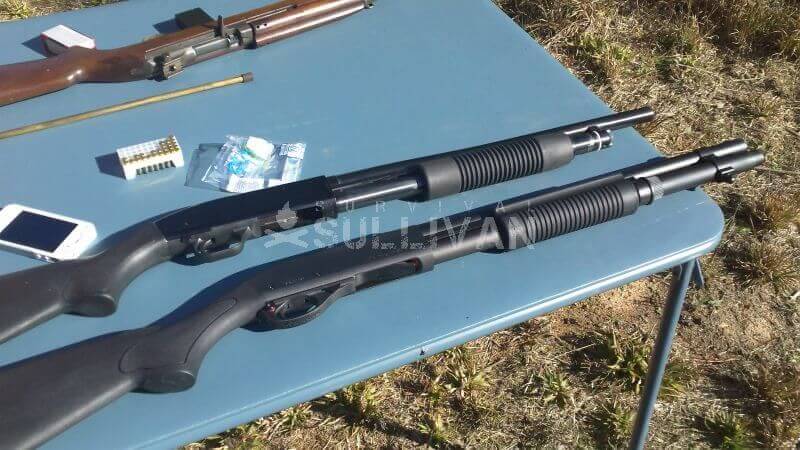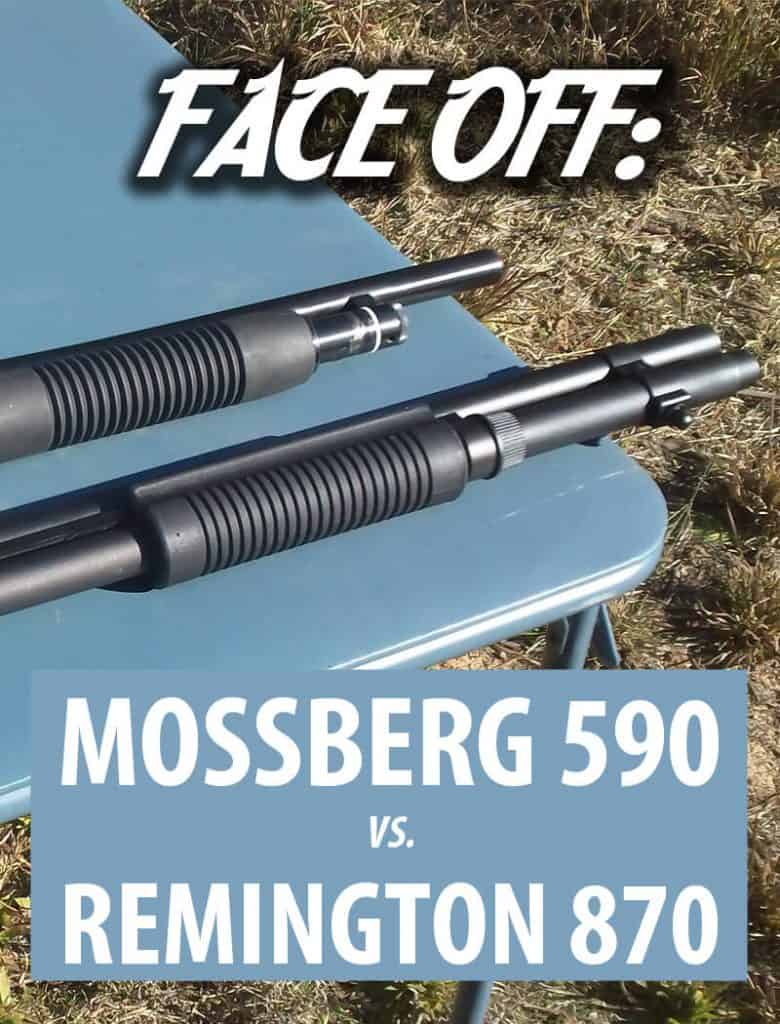Two titans of American firearm manufacturing, Mossberg and Remington, producers of two of the most prolific, rugged, and reliable shotguns that the world has ever seen. They are of course Mossberg’s 500 and 590 families and Remington’s 870. Between them, these two shotguns have been cranked out in numbers totaling tens of millions.
Each has stalwart, die-hard fans and scathing critics and the rivalry between the two groups nearly eclipses anything that can ginned up by competing pro sports teams. You rarely encounter such impassioned and oratorical pronouncements about the merits and flaws of guns as you will among the users of these two fine (both of them!) shotguns.
The question is which one is superior? Is one superior? If you were a new prospective buyer, which one is the best choice? In this article, I will strive to answer that question for inquiring minds. I have plenty of experience with both guns, both my own and students’ guns.
My intent is to illustrate for the reader the most essential differences between the two, an overview of their perks and flaws that may tip the balance of your favor toward one or the other so you can make up your mind with confidence.
But whatever your intended purpose, be it home defense, law enforcement duty, deer hunting or something else, you’ll wind up with a pump-action shotgun that is right for you.
Note that we will only be comparing the conventional tube-fed versions of these classic scatterguns, not the new and fancy detachable box magazine-fed versions.
So, grab your popcorn, and a box of shells and dig in.
Table of Contents
Family Relations
In order to fairly assess these two scatterguns supreme against one another, you must understand the differences between the models and their variants. Mossberg has the 500 and 590, and furthermore the 590A1.
Remington’s 870 are all one big happy family, but there are several “trims” that feature greater or lesser quality depending on how they were made.
Think about it: you would not compare a top-of-the-line Ford to an entry-level Chevrolet, would you? Except as an academic exercise, no you would not. The same with our shotguns here today.
While these differences in model or variant make absolutely no difference in the manual of arms for either family, they do determine what accessories or replacement parts you can fit to the gun.
We’ll start with Mossberg first and then move to the Remington. After we all get set on the essential differences we’ll dig into the head-to-head comparison.

Mossberg Models 500 and 590: Differences
The Mossberg 500 and 590 are essentially the same action, but they do have some important design differences you need to be aware of. The 590 and 590A1 are basically identical, only the A1 has some heavy-duty upgrades.
Once more, there are no manual of arms differences between any of them (sights notwithstanding) but which one you choose will make a difference when it comes time to choose add-on parts and other accessories, particularly magazine tube extensions and some forends.
The most obvious difference between the 500 and 590 is in the way the barrel secures to the magazine tube: the Model 500 features a lug with captive screw that is fastened to a hole on the end of the magazine tube.
The 590 uses the more common hoop-shaped lug that is clamped in place by screwing on the detachable magazine cap.
Bottom Line Up Front: On the 500, you are stuck with the magazine capacity conferred by the mag tube itself, and ergo the corresponding barrel length. Increasing the capacity means a new mag tube and a new barrel.
This means much more money than a simple crew on magazine extension. The 590, as you have probably guessed, only needs the aforementioned magazine extension; no new barrel required.
Additionally, a revised magazine follower in the 590 allows one extra shell than the same length of magazine tube on a 500. Also, 590s come equipped with a bayonet lug sized for U.S. military standard bayonets. Nice to know it is there if you want to get crazy, I guess.
The sum of these differences may not add up to much for some users, but the 590 definitely has an advantage when it comes time to increase capacity.

Heavy Duty: 590 vs. 590A1
Simply, the 590A1 is the heavy duty and U.S. Military adopted version of the gun. The most noticeable upgrade is the very beefy, very heavy barrel.
This thicker barrel may require model-specific forends, or minor fitting to adapt standard 590 forends. Additionally, the safety switch and trigger housing are also steel instead of plastic. The 590A1 retains the bayonet lug from the regular 590.
The result is a heavy shotgun that can withstand truly abusive handling and keep running. The weight difference is noticeable, but compared to the 590 is if you desire the most rugged gun in Mossberg’s broad lineup the 590A1 is the undeniable choice.
The Big Green Family: Remington’s 870 Variations
The 870 has been produced in a bewildering array of variants over the years, but discounting all the one-off variations, special editions, and less permanent models, you can get an 870 in one of several major “trims,” these being the Express, Tactical, Wingmaster and Police (870P) versions.
The differences between these models is not as obvious to the uninitiated as the difference between the Mossberg clan, above.
While these varying “models” do usually feature different options, the heart and soul of each action are the same. Each features a steel receiver, but what is not the same is the level of fitment, finish, and small-component quality that goes into each.
The Express and Tactical trims are mostly identical on this totem pole, and both occupy the lowest end of the strata. Machining is and finishing are both far rougher than higher grades. The actual finish applied to these guns is a cheap, black coating.
Essential small parts are MIM (Metal Injection Molded), not machined and fitted from bar stock. Springs of all kinds are of lower quality than the higher end 870s. Newer production Express and Tactical 870s have plastic trigger guards. All around, quality control and assurance are only average on this grade of shotgun.
The Wingmaster (the higher end hunting variant) and the Police models both feature a far higher level of quality components, assembly and finishing. The Police model is actually made in an entirely separate area of the factory.
Police guns are typically finished in a corrosion-resistant metal coating and the Wingmasters are often blued. Of the two you can expect to get a Wingmaster with a very long barrel and short magazine tube, necessitating you swap both for defensive purposes, unless a long, unwieldy and 3 shot pump shotgun appeals to you for self-defense.
The Main Event
Ok, now that we have addressed the major differences between our two contestants, we can start pitting them against each other. I have broken this dissertation up into major categories for easy reference between the two based on features. At the end I will include x-factors, perks, flaws, and other quirks.
Action
One major difference between Mossberg and Remington shotguns is the metal comprising the receiver: Remingtons are all steel. Mossbergs are aluminum.
Both are still suited to shoot a full-time diet of full-power 12 gauge, be it buckshot or slugs.
The lockup of bolt to barrel in each is steel-on-steel, and otherwise, both shotguns have proven themselves time and time again in all manner of environment, so there is no innate advantage to one over the other.
The 500/590 and 870 both feature dual, steel action bars for sure operation and to prevent bending. The designs differ in their attachment to the forend and each other: Mossberg bars are secured by pressed pins to a separate slide (“pump”) assembly. The Remington action bars and slide are unified, and one piece.
What does this mean to you, the shooter? A couple of things. The one piece Remington unit does lend itself to that shotgun’s overall “smooth” feel when running the action where the Mossbergs often have a slight rattle and feel a little sloppy. Note that this loose feeling does nothing to affect reliability.
The Mossberg unit is easier and cheaper to service when required, as a defective or worn action bar can simply be swapped out for a new one without the need to buy a more expensive one-piece unit.
All in all, so far as feeling is concerned Remington is the clear winner here: quick, smoother and a joy to run. An enhanced and tuned Remington action can hardly be beaten among pump shotguns, save perhaps by a slicked-up Winchester.
Too, as time goes on and the gun wears in, Mossbergs often feel even looser and sloppier. This may not affect serviceability one iota, but it remains.
Where the Mossberg starts to beat the Remington is in the internals: the 870’s dinky single extractor does nothing to inspire confidence next to its competition chunky, dual extractor claws. What’s worse is the Remington extractor may be a MIM part, unless you get a Wingmaster or Police model.
Look also at the ejectors: Mossberg 500/590s are screwed in and easy to replace. For some God-forsaken reason Remington is still utilizing riveted-in ejectors. The shell stops retaining rounds in the magazine tube are similarly easy to replace on the Mossberg models, but semi-permanently staked in on the Remingtons.
This policy of confounding serviceability continues with Remington’s soldered on magazine tube. 500s and 590s are both screwed in. This all adds up to Mossberg shotguns being considerably easier to work on with the right tools and just a little know-how. Remington shotguns are no picnic for anything beyond routine maintenance.
Controls
One of the biggest tipping points for prospective purchasers of these two fine guns is the control setup. Both Mossbergs have the safety situated on the tang, or hump at the back of the receiver, pressed forward for fire and backward for safe.
This is an excellent design and totally ambidextrous, but one that does not work well with pistol grips if you prefer one on your scattergun. This is because it would mandate either freakishly long thumbs to reach while retaining your firing grip, or breaking the firing grip completely to actuate the safety.
All 870s have their safeties located immediately to the rear of the trigger. Pressing the safety from right to left (revealing a red band) is fire. The opposite is safe. Compared to the Mossberg, the safety works great with any kind of stock but is not the most intuitive for left handed users.
The final control, the slide release is also different: Remingtons use a blade-like lever that extends just beyond the trigger guard on the left side of it, and this is pulled rearward to release the forend when locked.
Mossberg 500/590 releases are immediately behind the trigger on the left side, tucked between the bottom of the receiver and the trigger assembly, and are pressed up to release. Either works just fine for shooters of either hand, so no advantage there.
Perks, Flaws, and other Quirks
Both of these shotguns are enormously, massively popular, as mentioned above, with millions and millions produced and in circulation.
OEM and 3rd party manufacture of parts, enhancements, and accessories is nothing shy of incredible and will not be slowing for the foreseeable future. You can get additional ammo caddies, optic mounts, new furniture, lights, lasers, barrels, extended controls, sling mounts, and far more.
As noted earlier, pistol grip stocks are not a great idea on Mossbergs due to the safety location. This is not something that is impossible to overcome, but your body works the way it works
Having to come off the grip entirely to run a safety versus it being located ergonomically and conveniently under your thumb with a standard stock is just not a worthwhile trade.
If you must, must have a pistol grip, consider the Remington 870.
Now, a biggie: since Remington’s recent financial woes and bankruptcy, not to mention their acquisition by another uncaring conglomerate way back in ’07, their quality issues and general decline of their guns has been the subject of much talk in the gun sphere.
Reports of the low-end Remingtons having very rough actions, parts breakages and general jankiness are manifold. If one cannot or is unwilling to seek out an older pre-07 Remington, caveat emptor.
With so many in circulation though it will be a small task to find a used Police or Wingmaster model, though, and the money you save will go far toward tuning up a Wingmaster.
Mossberg has not been entirely free of QC/QA issues over the years, but have never seen a dip in quality like Remington has.
This has nothing to do with the designs of either shotgun, per se, and every company can have high times and low over the course of its life. It just so happens the beloved Big Green is currently a shadow of its former self.
Lastly, both shotguns can be greatly improved upon by tuning and the careful attention of a skilled gunsmith. But between the two, the Remington action can be taken farther than the Mossberg 500 or 590.
Special Models
The Mossberg Shockwave and Remington Tac-14
If there is one thing that both Remington and Mossberg shotguns have proven over the years it is that they continue to secure just about every imaginable sector for pump-action guns.
There is no niche that is not covered by some model! This definitely counts for shorties, too, and one of the single best contributions made in this regard is the offering of Mossberg’s Shockwave series and Remington’s Tac-14 lineup.
The Mossberg Shockwave is a short-barreled shotgun that is classified as a “Non-NFA Firearm” by the BATF. This means that it can be purchased without having to go through the extra hassles of owning a Class III weapon.
The Shockwave is based on the Mossberg 590 platform and sports a 14-inch barrel. It also has the Shockwave Raptor grip, a bird’s-head style grip which is specially designed to reduce recoil and muzzle rise compared to typical “pistol grip only” setups. The grip is made of durable polymer and fits most hands comfortably.
A strap is mounted to the forend to aid in controlling the gun and to prevent it from being dropped.
Even more importantly it prevents the support hand from slipping in front of the muzzle for inadvertent amputation! The Shockwave can also mount a Picatinny rail for mounting accessories, such as a light or laser, or optic.
The Remington Tac-14 is based on the Model 870 platform and also features a 14-inch barrel.
It is, like the Shockwave, classified as a “Non-NFA Firearm” by the BATF and can be purchased freely over the counter in most places without having to go through the extra hassles of owning a Class III weapon.
The Tac-14 also sports a bird’s-head grip and is available in a variety of finishes, both black and camo.
The primary practical difference between the Mossberg Shockwave and the Remington Tac-14 is, as mentioned above, the control setup inherent to both of the shorties’ parent lines.
Both guns are offered primarily in 12-gauge and are perfect for home defense, emergency hunting usage, anti-carjack duty, or just about any other activity that you might want to use a short shotgun for.
Now, the obvious question that everyone wants answered is whether or not these guns are easy to shoot, and actually practical? I can answer definitively “no” to the former, and a resounding “yes” to the latter.
These guns offer a huge leap in ergonomics and handling compared to legacy pistol grip only shotguns, but will still put your technique to the test. You’ll start feeling it after you run a box of shells through either!
That being said, it is possible to be far quicker and more effective with these little-bitty stakeout guns than you might be imagining, so if you need a short gun and don’t want the hassle of kissing the BATF’s ring, definitely give them a look!
Box Mag Mayhem
Detachable magazine-fed shotguns are something of a crown jewel for shotgunners.
The notion of having the power and capability of a scattergun without the lengthy reload and limited capacity of traditional fixed tube magazines is just too appealing to resist.
Unfortunately, the majority of semi-auto shotguns that utilize detachable mags are either not very good in the first place, or finicky, temperamental machines.
But there are a couple of shining stars in the detachable magazine shotgun world- the Remington Model 870 and Mossberg 590 series shotguns.
By adapting their tried and true pump action guns to make use of large, easily removeable box magazines capacity and balance have been greatly improved while allowing shooters to quickly and reliably change out ammunition types with far less fiddling than legacy guns.
This is a huge advantage for tactical shooters and hunters alike!
Yes, the mags are large, somewhat cumbersome and expensive, but this is a small price to pay for a huge improvement in overall capability.
The Verdict
Both families of these quintessential American firearms are rugged, reliable, and durable on the whole. Either can admirably perform in a self-defense, hunting, or survival role.
While each has its own pros and cons, and each certainly has its own rabid fanbase, neither one is the clear and uncontested champion, and neither is a dog. Choose whichever one has the most features you like, and be confident that you are choosing an excellent pump shotgun.


Charles Yor is an advocate of low-profile preparation, readiness as a virtue and avoiding trouble before it starts. He has enjoyed a long career in personal security implementation throughout the lower 48 of the United States.

Genuine 500 is kinds ugly yo strip v. Girly 870 turk clones I own…
You overlooked one of the major issues between the two. The loading gate on the 870 vs. the 590a1. That’s a major difference that affects the manual of arms. I prefer the Mossberg’s open feed system by far.
Just yesterday I sent my second 590 back for service, I have 3. I am very leery now despite their heavy duty build and am going to go to a Benelli or Beretta. Loss of confidence in the platform has me concerned especially on these 2 extremely low round count shotguns. Ymmv I suppose but I’m done with the Mossy.
Having owned both, I ended up keeping with the Mossberg. I have never had a failure, including with my old Western Field Mossberg from the 1960’s with single action bar on up to the 835’s and 590A1 I own. I liked the Remington, but mine was an Express that rusted in high humidity (though it took many ducks and geese). But longer magazine tubes are just plain easier to install with Mossbergs than with Remingtons.
If you are looking to spend less the Coast to Coast Master-Mag pump shot guns are mossberg shot guns with Master- Mag on the barrel not Mossberg also I bought a Sears TedWilliams 30-30 witch is a modle 94 just does not say Winchester on it paid a lot less for it